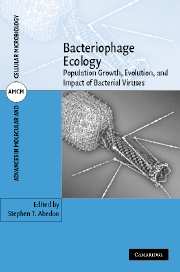Book contents
- Frontmatter
- Contents
- About the cover
- List of contributors
- Foreword by Bruce R. Levin
- Preface
- 1 Phages, ecology, evolution
- Part I Phage ecology
- Part II Phage evolutionary biology
- Part III Phage ecology in environments
- 10 Aquatic phage ecology
- 11 Phage ecology of terrestrial environments
- 12 Phages, bacteria, and food
- 13 Interaction of bacteriophages with animals
- 14 Phage ecology of bacterial pathogenesis
- Part IV Modeling phage ecology
- Index
- Plate section
13 - Interaction of bacteriophages with animals
from Part III - Phage ecology in environments
Published online by Cambridge University Press: 29 September 2009
- Frontmatter
- Contents
- About the cover
- List of contributors
- Foreword by Bruce R. Levin
- Preface
- 1 Phages, ecology, evolution
- Part I Phage ecology
- Part II Phage evolutionary biology
- Part III Phage ecology in environments
- 10 Aquatic phage ecology
- 11 Phage ecology of terrestrial environments
- 12 Phages, bacteria, and food
- 13 Interaction of bacteriophages with animals
- 14 Phage ecology of bacterial pathogenesis
- Part IV Modeling phage ecology
- Index
- Plate section
Summary
INTRODUCTION
A number of bacterial virus strains interact with eukaryotes, including with humans. The study of these interactions is still in an early discovery phase. To put this situation in perspective, it is estimated that there are about 1012 cells in a human, while the number of bacteria, and their viruses (most of which inhabit the large intestine) outnumber these human cells by a factor of at least 10 (Bäckhed et al., 2005). Study of the interactions of bacterial viruses, their genes, and their gene products on their animal “co-hosts” has only really begun. Early studies concentrated on their anatomical distribution in animals. These studies were followed by investigations of interactions with the immune system, particularly the adaptive immune system. More recently, studies have been initiated on the interactions of these viruses with the innate immune system and mammalian cells. Unfortunately, we currently do not have the technology to culture many of the bacterial strains associated with humans and other animals, which limits our ability to study the viruses associated with these organisms. However, the development of new molecular methods, particularly high-throughput genomic sequencing, are now providing tools to characterize the human “microbiome” in both normal and disease states (Relman, 2002). Despite the current dearth of knowledge concerning phage interactions with animals, there are already significant efforts to use the knowledge we have, to engineer the few phage strains that have been studied for antibacterial, vaccine, and gene therapy applications.
- Type
- Chapter
- Information
- Bacteriophage EcologyPopulation Growth, Evolution, and Impact of Bacterial Viruses, pp. 332 - 352Publisher: Cambridge University PressPrint publication year: 2008
- 10
- Cited by



